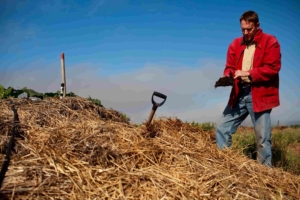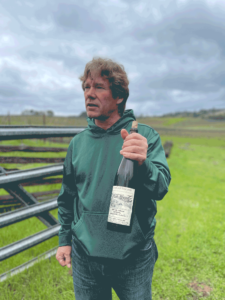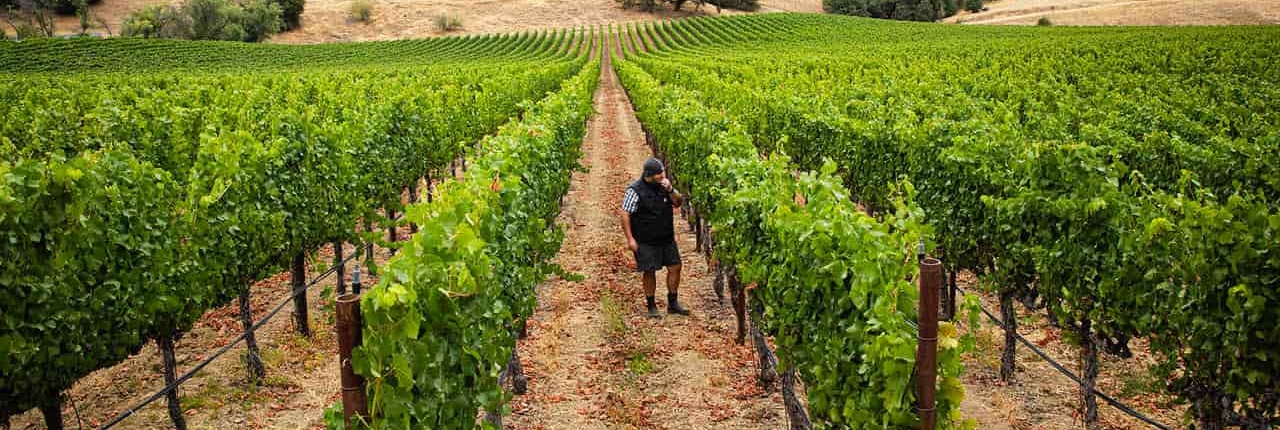Anderson Valley has quietly emerged as one of the most coveted destinations for winemakers seeking to produce exceptional Pinot Noir in the New World. Despite its relatively small size and remote location, this hidden gem has captured the hearts and palates of discerning wine enthusiasts and industry insiders alike.
For decades, Anderson Valley remained undiscovered by many in the wine world. However, those who had the privilege of living in the appellation or who stumbled upon it during their early winemaking careers quickly recognized its potential and understood that Anderson Valley possesses the rare combination of terroir, climate, and vineyard practices necessary to produce truly exceptional Pinot Noir.
Some of the early winemakers of the appellation from wineries like Husch, Navarro, Lazy Creek, and Greenwood Ridge knew they had found something special, and from their efforts and vision for the valley, there are now as many as 80-100 different producers who seek out our coveted fruit from year to year.
Ted Lemon of Littorai Wines Anderson Valley Discovery in 1993
 “No wine region exists without the adventurous souls who paved the way, often with little recognition and even less financial success. In the 1890s Italian families established grape growing on Greenwood Ridge, later Swiss Colony made attempts and after prohibition, Dr. Donald Edmeades planted the first modern commercial vineyard in 1964. He was followed by Tony and Gretchen Husch and Ted Bennett and Deborah Cahn of Navarro. All of these pioneers laid the groundwork for the modern success of Anderson Valley. Without their efforts, none of us would have ever dreamed of growing world class grapes in Anderson Valley.”
“No wine region exists without the adventurous souls who paved the way, often with little recognition and even less financial success. In the 1890s Italian families established grape growing on Greenwood Ridge, later Swiss Colony made attempts and after prohibition, Dr. Donald Edmeades planted the first modern commercial vineyard in 1964. He was followed by Tony and Gretchen Husch and Ted Bennett and Deborah Cahn of Navarro. All of these pioneers laid the groundwork for the modern success of Anderson Valley. Without their efforts, none of us would have ever dreamed of growing world class grapes in Anderson Valley.”
– Littorai Winemaker & Proprietor Ted Lemon.
Ted Lemon from Littorai Wines is a pioneer of the region in his own regard. After studying and working in Burgundy, Ted & his wife Heidi sought out the best regions in CA to make Pinot Noir and Chardonnay, and landed in Anderson Valley & the Sonoma Coast. He made his first Anderson Valley Pinot Noir in 1993 from One Acre Vineyard, which was before Goldeneye Winery was established in 1996 as one of the appellation’s first Pinot Houses, and arguably the beginning of the Pinot boom in Anderson Valley.
Littorai was the first to vineyard designate Savoy, Roman, Cerise and Wendling Pinot Noirs, which have contributed to the notoriety of these vineyard sites and the region. In addition to crafting his sought-after wines, Littorai’s organic and biodynamic farming practices have contributed to bringing awareness to the sites he works with, and has helped to bring Anderson Valley Pinot Noir on the global stage.
Other Small Producers Getting into the Pinot Game in the 2000s

Several smaller producers came after Ted and Goldeneye and established storefronts in the Valley, including Douglas Stewart of Breggo Cellars, Van Williamson of Witching Stick, Phil Baxter of Baxter Winery, and Kristy Charles & Joe Webb of Foursight Wines, all of which are still operating as of 2024 and have access to estate fruit or ongoing fruit contracts.
“I love Pinot Noir grown in the Anderson Valley – there’s often an underlying wild, feral quality in the fruit that I find is a really good fit for my style as a winemaker. Having that quality in there helps create a complete wine; and a wine that communicates a sense of place”.
– Pangloss & Texture Winemaker Erich Bradley
While others from out of appellation like Erich Bradley winemaker for Texture Wines and Pangloss Cellars found a way into the community after discovering Anderson Valley during the Pinot boom of the late 1990s, from regular travels to and from the Mendocino Coast.
The diverse landscape and unmistakable marine influence immediately struck him as ideal for growing sublime Pinot Noir. However, it wasn’t until 2007 that he seized the opportunity to make wine from the region, when he crossed paths with Chris Demuth and began sourcing fruit from his eponymous vineyard. In 2012 he began a relationship with Bill & Nancy Charles gaining access to one of the marquee vineyards in Boonville, and where he continues to make a Pangloss Charles Vineyard designate.
In 2012, Erich’s introduction to Paul Ardzrooni and Norman Kobler marked a significant turning point. This connection brought Ferrington Vineyard into the Texture fold, with Wendling Vineyard following a few years later and Texture being completely focused on Anderson Valley fruit. At this point, Erich’s bond with Anderson Valley’s untamed beauty was solidified, establishing it as a cherished retreat as well as a place that would allow him to craft wines that authentically express the unique character of each vineyard site..

One of the factors contributing to Anderson Valley’s allure is its limited acreage devoted to grape cultivation, with approximately 2500 acres planted. This scarcity of available land has helped maintain the region’s exclusivity, ensuring that the fruit remains prized and sought after. Additionally, the cost of farming in Anderson Valley is higher than other wine regions due to smaller vineyard sizes, organic farming practices, hillside elevation, remoteness, and limited labor availability.

Vineyard Manager Norman Kobler of Philo Vineyard Solutions, and son of the original Lazy Creek winery founders, explains, “for higher quality fruit, it is all hand labor. Crews have to go through the vineyard five or six times every vintage, which adds to the cost of production”. As a result of more expensive and limited fruit, the grapes cultivated in Anderson Valley are primarily reserved for smaller boutique producers or boutique programs in larger wine portfolios, where there is a commitment to preserving the unique characteristics of the terroir in their wines.
The passion and dedication of many of the region’s winemakers have played a pivotal role in elevating Anderson Valley’s reputation within the industry. Their commitment to crafting high-quality, terroir-driven wines has garnered widespread acclaim and helped put the region on the map. Despite the challenges of accessing fruit from Anderson Valley, many winemakers express a deep-seated desire to work with grapes from this esteemed appellation.
However, as Anderson Valley’s popularity continues to soar, obtaining fruit from the region has become increasingly challenging for smaller producers to join the community. Many vineyards have been acquired by larger wineries based in neighboring Napa or Sonoma, further limiting the availability of grapes on the open market. The average price for Anderson Valley Pinot Noir grapes exceeds $5,000 per ton and can soar as high as $8,000, making it financially prohibitive for some aspiring winemakers to enter the appellation.
Nevertheless, it is essential to acknowledge and honor the contributions of the pioneering individuals and small-scale producers who were instrumental in establishing Anderson Valley as a premier Pinot Noir winegrowing region. Their dedication and innovation have laid the foundation for the region’s current success and desirability within the industry.
Fortunately, you can meet many of these producers at the annual Anderson Valley Pinot Noir Festival held every May.
Anderson Valley stands as a testament to the potential of New World wine regions to produce world-class Pinot Noir. Its unique combination of natural attributes and the passion of its winemaking community make it a truly special destination for those seeking to create exceptional wines that reflect the essence of the land.



